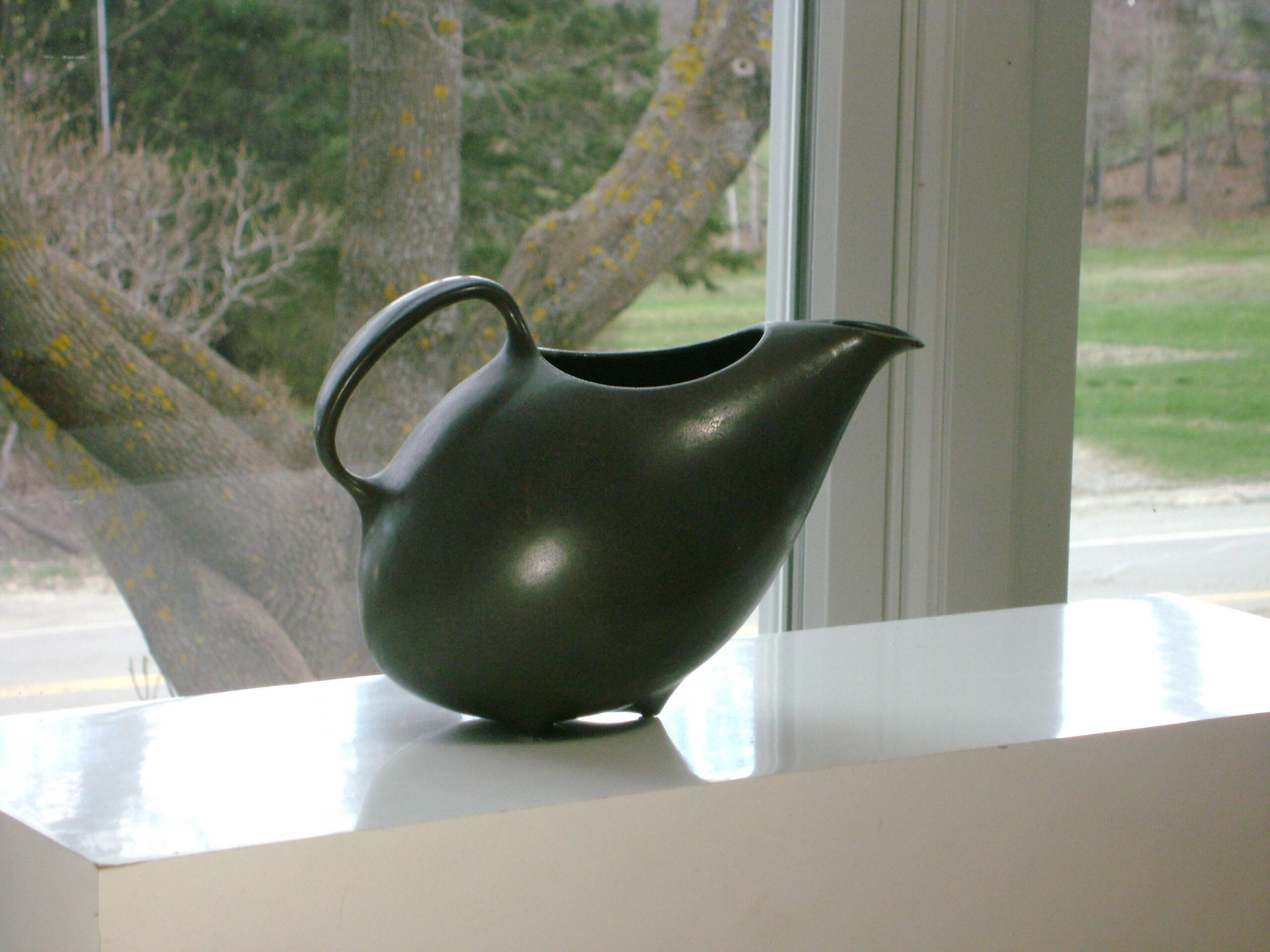The grassroots fertilizes the mainstream but needs its independence!
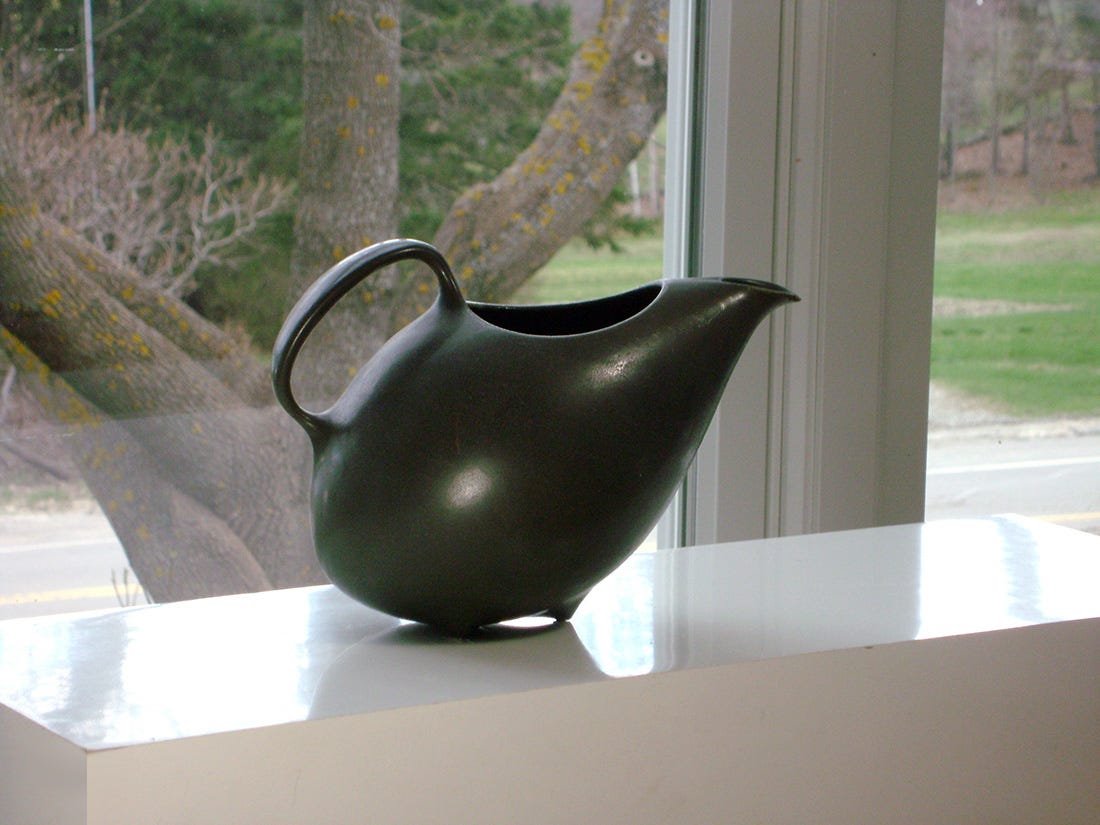
Not found in your Wikipedia mainstream history! This unique hand-created slip-cast ceramic pitcher was designed mid-twentieth century by my Dad, Weston Neil Andersen. It has a companion pitcher that is smaller with a different handle and is also finished in this ebony brown glaze also designed by Weston. Soon to be listed on Andersen Design!
I recovered boxes from storage filled with the earliest midcentury examples of my parent’s work from the forties and fifties. It is my inheritance to ensure that these works are properly preserved, somewhere and so I was overcome by the pressing importance of finding a space, but today I am working on a simpler project of photographing the work and presenting these rare and unique objects online, which is no small amount of work.
I was really pleased to find the collection of a series of mugs that my mother decorated with faces on a rare form that I speculate was designed on commission. These mugs correspond with the time when the movie Carousel was filmed in Boothbay Harbor. During that time there were numerous actors and others associated with the filming came by my parent’s ceramic gallery located in a two-hundred-year-old barn on a grassy hill along the side of the road. They were on a mission to have their portraits painted by my mother on the ceramic forms designed by my Dad.

Historic location for historic innovation in a historic technology
The actors and other film people didn’t mind that my parent’s gallery was located in a two-hundred-year-old barn made out of wooden pegs and boards missing from the roof to let the rain fall and the swallows fly about, in fact, that was part of the fascination. Today a cult of rigidtarians led by a donor cabal trying to bulldoze over everything old and historic and replace it with mainly monotonous new buildings would call the beautiful old barn “decrepit” but it was a well-built and strong structure and not rotting despite the open-air ceiling and it had a genuine narrative character that would be attractive to those in the film industry.
The kid’s job was to watch out for customers. I frequently flew through the air from the barn loft to greet the customers before dashing down the hill to alert my parents.
The actors and other film people didn’t mind that my parent’s gallery was located in a two-hundred-year-old barn made out of wooden pegs and boards missing from the roof to let the rain fall and the swallows fly about, in fact, that was part of the fascination. Today a cult of rigidtarians led by a donor cabal trying to bulldoze over everything old and historic and replace it with mainly monotonous new buildings would call the beautiful old barn “decrepit” but it was a well-built and strong structure and not rotting despite the open-air ceiling and it had a genuine narrative character that would be attractive to those in the film industry.
The kid’s job was to watch out for customers. I frequently flew through the air from the barn loft to greet the customers before dashing down the hill to alert my parents.
When we moved to East Boothbay in 1958, the barn was destroyed, but ironically there appeared on the side of the structure that once was our living and production space, the ubiquitous yellow Happy Face. Was it subconscious remembrance of the home of a precursor to the Happy Face meme that was created on a ceramic mug in a two-hundred-year-old barn that had once existed on the hillside by the road?
To date, there are seven such mugs that I know about They are very delicately cast, and yet they have survived all of these years with only one having a chip on the lip, which does not mar its value as a cultural artifact. These historical mugs are not something one would use for everyday drinking. They are relics of a time now gone.
The mug with the chip is the Happy Face mug that my mother created before there was the Happy Face that proliferates all over the place to this day. The chip is on the other side of the mug where the Happy Face closes its eyes to look within. On one side of the mug is a decorative jewelry-type vine that winds around the ear and embraces the eye, making the face into a mythical personification of a forest spirit.
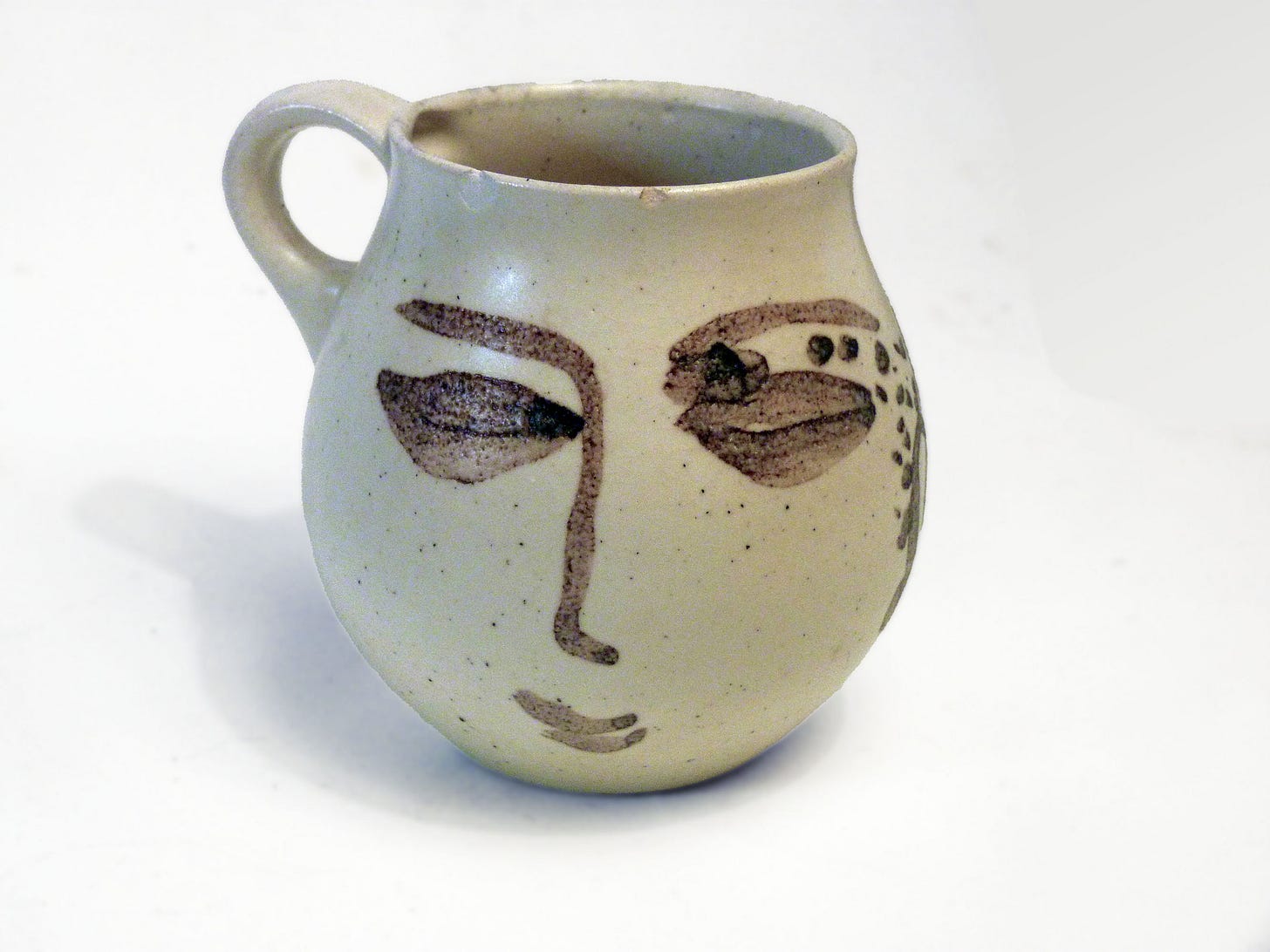
The only part of this mug that resembles my father’s sensibilities is the handle and so I believe that this mug was created as a commission and the person commissioning the work dictated the design of the form. It might even have been by a man enamored by my mother who psychologically wanted to diminish or replace my father. On the other hand, it might have been more innocent as the globe is a natural form for a face portrait.
My father’s basic form was this oval scoop, which was developing into a series of other forms in the fifties:
When Dad designed a globe form, he intersected it with this curve, This was how his designing sensibility was evolving at the time these mugs were made.
His mug designs were straight or gently reaching outward.
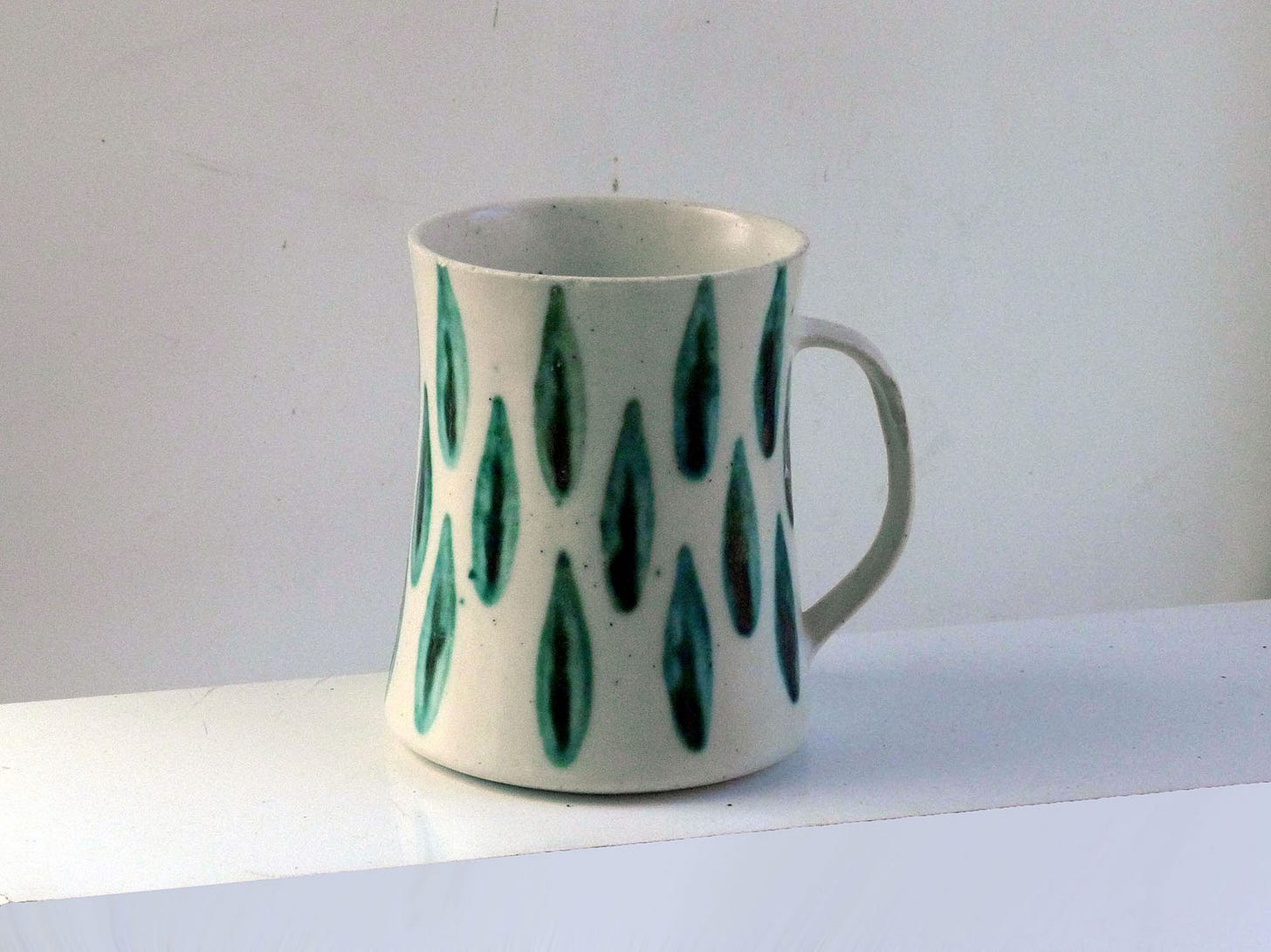
The design of this series of mugs harks back to an earlier area of design that was more conventional at that time that midcentury design was emergent. I speculate that these mugs were decorated by my mother in preparation for the commissioned portraits. She wanted to get the feel of how the face should fill the form before doing the portraits in person.
This series of mugs as cultural artifacts is self-evident. They are a spontaneous expression of the individual self, a message inherent in all handmade objects, extending now into the world of writing and art as some will tell us AI can do it better so that human writing takes on the same character and meaning as handmade (human-made) crafts.
In my parent’s day, it was plastics that could do it better. In response my parents started a company that created a handmade product affordable to the middle class, How does one do that? You slip-cast it!
The fifties were a time when designers introduced a new sensibility into the homes of the middle class. The reason for slipcasting was to make hand-crafted art affordable to the middle classes. It was a choice made about which field of human interaction my parents would participate in. It’s the same as choices being made today in corporate culture as the people with whom one interact make the difference in whether one wants to engage or not. My parents chose the middle class. I don’t think they saw it as a radical choice, but as time would tell, indeed it was radical to choose to make art, not for the prestige objects market but for the middle-class market.
In those days there was barely a non-profit sector and the state did not manage the economy. The phenomenon of non-profits proliferating everywhere emerged in the sixties. In 1952 in Maine, the economy was a free enterprise economy with many small businesses, not the category of businesses that are traded on the stock exchange.
My Dad, who founded Andersen Design with my mother, was very philosophical and that was imparted into the choices he made. When I was living in New York City I became involved in reading esoteric and quantum philosophers. When I returned to Maine, I found my Dad reading the same or similar books, so I feel very connected to my Dad’s way of thinking about everything.
Out of this series of mugs, one mug is a portrait of a real person, of me at around the age of seven. I frequently sat alongside my mother when she decorated and sometimes I decorated a form that she had pre-signed. Here is my portrait on a mug: I call this mug Blue Sweet Sue, because my first name is Susan, and because one side of the mug is blue and the other sweet.
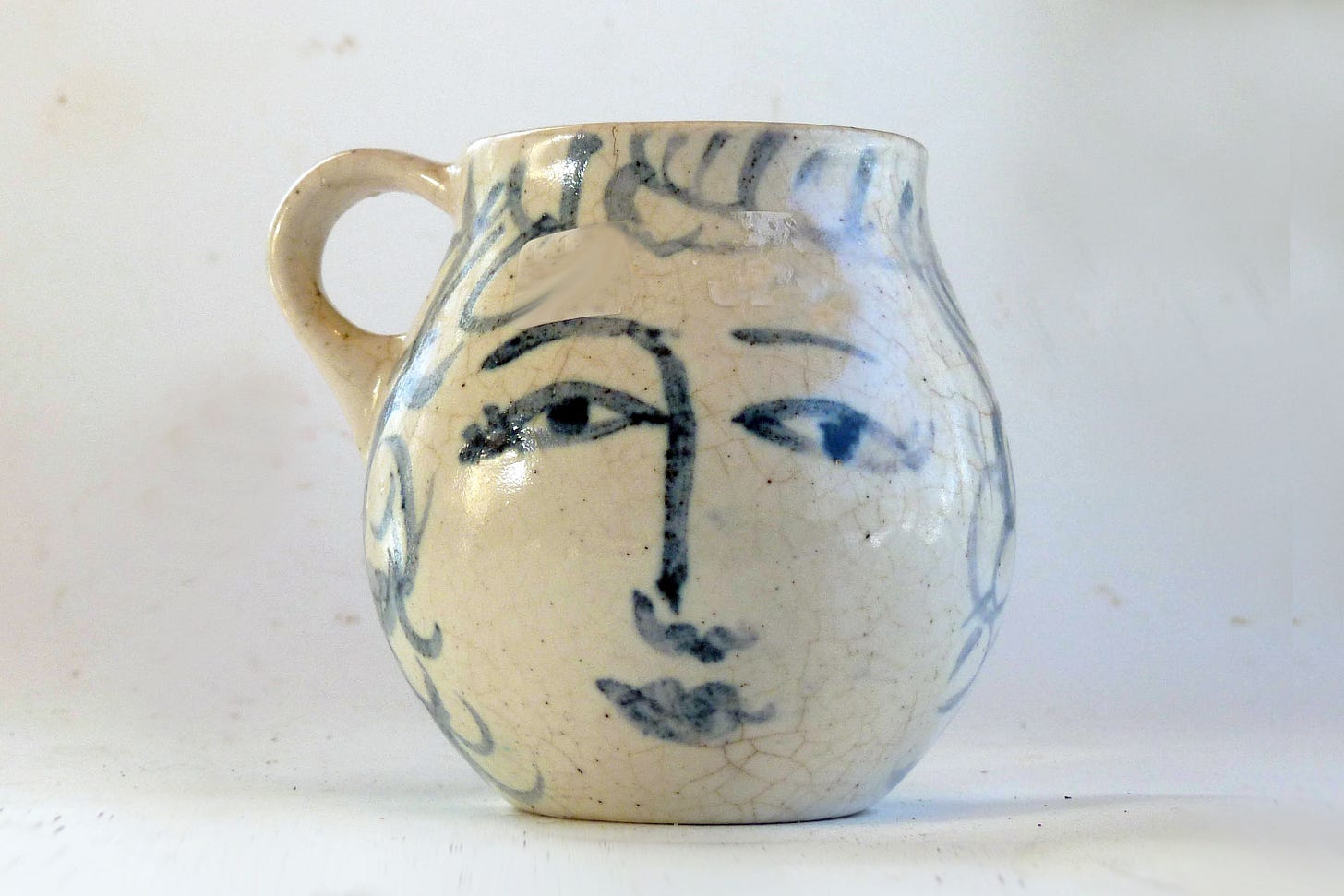
Another reason for speculating that these mugs were done in preparation for commissioned work is that among them I found a mug that I decorated and signed. My work is done on a mug that my father designed for the Andersen Design line. I might have been given this mug to decorate because only a limited number of mugs in the globe form were cast. I signed the mug in the way that my mother signed the Lady in Blue mug:

This is my mug

I suspect that It was when I produced this mug that my mother did this:
I like hers better!
Brenda was a precursor to mainstream trends. she painted celebrity portraits using the medium of production as the art form before Andy Warhol made the concept famous, or at least so in certain circles. She created a Happy Face Mug before there was a Happy Face Meme.
Designers look to the streets and the flea markets for ideas because ideas emerge at the grassroots of society first. The same is true for large educational facilities that create a grassroots field made up of all who use the facilities.
Today the Boothbay Peninsula, where Andersen Design once found a home, leads the way in pursuing the replacement of the historical culture, with former homes of the general populous being transformed and occupied by the short-term rental industry, with developers planning city blocks of corporate-owned single-family homes for the “workforce” where the individual spaces are reduced in size not permitting of creative pursuits so that the only space for such pursuits will be the new “demonstration school” modeled on the University of Maine which claims intellectual property ownership of activities taking place within the facility- because it owns the facility- thanks to a lot of public funding.
The grassroots is the precursor to recorded history and by definition is rooted in natural innate human intelligence. Artificial intelligence is mathematically programmed by human intelligence and has a unique capability to detect emerging trends at the grassroots that mainstream human intelligence misses because human intelligence is emotional and psychological while AI is merely mathematical. AI does not have a psychological agenda.
New life proliferates in the grass but not every form matures into a form that infiltrates and transforms the mainstream. AI can identify new forms while they are still metaphorical quantum events struggling to become mass. I realized this when I discovered that Hrefs gives this newsletter the same Domain Authority rating as Wikipedia (91), not because I have a readership the size of Wikipedia but more likely because I exist outside the scope of Wikipedia. If someone wants to find what I write about, they will not find it on Wikipedia. For example, you will not find out anything about Andersen Design as a mid-century design company on Wikipedia because Wikipedia would not allow my edit that included Andersen Design in the history of midcentury design, nor will you find the history of Maine economic development policy since 1976 when the centrally managed economy was established under Governor Longley because Wikipedia would not allow that either. If you are looking for such information I am the source equal in authority in that domain as Wikipedia is in its domain. I am the grassroots and Wikipedia is the current mainstream. The mainstream relies on the grassroots for self-renewal and seeks to harvest the innovation of the grassroots for its own(ership).
The story of this series of seven mugs decorated by my mother on a rare form is the story of my parent’s rare experimentation in the market of prestige objects. The commission was not by kings but a personal individual portrait on a slip cast production work is a prestige object. If my speculation is right, somewhere there exists a series of these mugs with individualized portraits related to the person who commissioned the work. The mugs stand on their own merit but not as a representative of the work of Andersen Design which was born as a collaboration between a husband and wife.
Dad is not present in the design process of these mugs but he probably created the prototype, the mold, and slip cast the mugs. My mother decorated them beautifully. They are original and expressive of the individual freedom that starting one’s own enterprise imparts. That is why my parents did not go down the road of prestige object makers, but instead chose the path of personal freedom. In this example, we see that the prestige object process took my father’s creativity out of the process, which all too often happens within corporate hierarchical culture, and why there is much talk today about the spontaneous and creative teamwork sought after by corporate owners thrives best in small teams– emulating the small business environment. When that intersects with the prevalent ownership class-working class divide, small enterprises, owned by individuals deliver the best of all worlds. Why not follow that model, Boothbay Peninsula, I’m talking to you!
